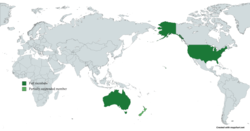
Back أنزوس Arabic ANZUS AST ANZYUS Azerbaijani АНЗЮС Bashkir ANZUS Breton ANZUS Catalan ANZUS Czech ANZUS Danish ANZUS-Abkommen German ANZUS Esperanto
 | |
 ANZUS member states | |
| Abbreviation | ANZUS |
|---|---|
| Formation | 1 September 1951 |
| Type | Military alliance |
| Purpose | Collective security |
Region | Pacific Rim |
| Methods | |
Membership |
|
The Australia, New Zealand, United States Security Treaty (ANZUS or ANZUS Treaty) is a 1951 non-binding collective security agreement initially formed as a trilateral agreement between Australia, New Zealand, and the United States;[1] and from 1986 an agreement between New Zealand and Australia, and separately, Australia and the United States, to co-operate on military matters in the Pacific Ocean region, although today the treaty is taken to relate to conflicts worldwide. It provides that an armed attack on any of the three parties would be dangerous to the others, and that each should act to meet the common threat. It set up a committee of foreign ministers that can meet for consultation.
The treaty was one of the series that the United States formed in the 1949–1955 era as part of its collective response to the threat of communism during the Cold War.[2] New Zealand was suspended from ANZUS in 1986 as it initiated a nuclear-free zone in its territorial waters. In late 2012, the United States lifted a 26-year-old ban on visits by New Zealand warships to US Department of Defense and US Coast Guard bases around the world. New Zealand maintains a nuclear-free zone as part of its foreign policy and is partially suspended from ANZUS, as the United States maintains an ambiguous policy whether or not the warships carry nuclear weapons and operates numerous nuclear-powered aircraft carriers and submarines; however New Zealand resumed key areas of the ANZUS treaty in 2007.[3][4]
ANZUS was overshadowed in late 2021 by AUKUS, a trilateral security partnership between Australia, the United Kingdom, and the United States. It involves cooperation in nuclear powered submarines that New Zealand did not support. Australia and New Zealand "are poles apart in terms of the way they see the world. ... I think this alliance underlines that they're going in very different directions,” said Geoffrey Miller, an international analyst at the Democracy Project in New Zealand.[5]
- ^ 'ANZUS treaty comes into force', URL: https://nzhistory.govt.nz/anzus-comes-into-force, (Ministry for Culture and Heritage), updated 5-Oct-2021
- ^ Joseph Gabriel Starke, The ANZUS Treaty Alliance (Melbourne University Press, 1965)
- ^ Alexander, David (21 September 2012). "U.S. lifts ban on New Zealand warships, New Zealand keeps nuclear-free stance". Chicago Tribune.
- ^ Kristensen, Hans (23 September 2012). "In Warming US-NZ Relations, Outdated Nuclear Policy Remains Unnecessary Irritant". Federation of American Scientists.
- ^ McClure, Tess (16 September 2021). "Aukus submarines banned from New Zealand as pact exposes divide with western allies". The Guardian. ISSN 0261-3077. Retrieved 27 March 2023.
Aukus submarines banned from New Zealand as pact exposes divide with western allies: Experts say Aukus military deal underlines Australia's increasingly close alignment with the US on China – and New Zealand's relative distance.